C.5 Performing ZENworks Third-Party Imaging in the Maintenance Mode
The Novell ZENworks Third Party Imaging utility that is available on the managed devices allows you to take an image and restore it either on the local device or the server. The utility uses the Windows Imaging Format (WIM) or Ghost Imaging Format. The utility also allows you to add and modify the disk partitions of the device.
The image that is taken with ImageX and restored by using the WIM bundle does not have any partition information. Consequently, it creates only one single partition on the destination hard disk. To prevent this issue, you must take an image by using ZENworks Control Center or the ZENworks Third Party Imaging utility in the maintenance mode.
Review the following sections for detailed information about the operations that can be performed by using the Novell ZENworks Third Party Imaging utility:
C.5.1 Launching the ZENworks Third Party Imaging Utility
-
Reboot the managed device to the PXE mode.
-
From the PXE menu, select the WinPE Maintenance mode.
The WinPE distro loads and the Novell ZENworks Third Party Imaging utility is launched.
C.5.2 Taking an Image of a Device and Storing it Locally
The ZENworks Third Party Imaging utility allows you to take an image of an existing device and store it locally. The image can be used to image a similar device or reimage the same device.
To take an image of an existing device and store it locally:
-
Click the Imaging menu > Take Image > Local.
The Take Image window is displayed.
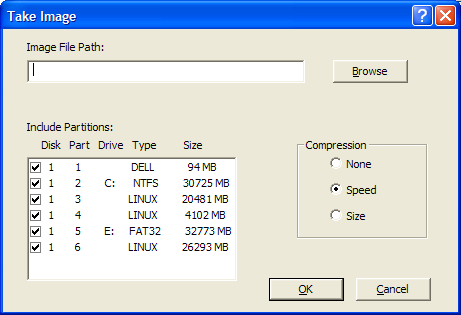
-
In the Image File Path field, specify or click Browse to browse for and select the path where you want to store the Windows Imaging Format (.wim) or the Ghost imaging format (.gho) files.
-
In the Include Partitions field, select the partition of the disk whose image you want to take. Do not select the drive where you want to save the .wim or .gho file.
By default, the Include Partitions field displays all the partitions of the device on which the Novell ZENworks Third-Party Imaging utility is launched. The drives are displayed for Windows partitions.
NOTE:The drives displayed might not correlate with the original drives of the device. You must ensure that the correct drive is selected.
-
Select one of the following compression options:
-
None: No compression is applied.
-
Speed: Optimizes the compression to allow for the fastest imaging time. Use this option if CPU speed is an issue. By default, this option is selected.
-
Size: Optimizes the compression to minimize the image file size to conserve disk space. This might cause Imaging to take considerable amount of time.
-
-
Click OK.
If the images are taken in the Ghost format, ZENworks additionally creates an XML file with the filename as image_name-ghost.xml in the same location as the image file. You must not edit the xml file. If you are taking an image of a device that has multiple disks, an image file is created for each disk and only one XML file is created per image.
If you want to move a Ghost image to a different location, you must move all the image files and the XML file specific to the image.
C.5.3 Taking an Image of a Device and Storing it in a Remote Repository
The Novell ZENworks Third Party Imaging utility allows you to take an image of an existing device and store it in a remote image repository on a shared-network path. The image can be used to image a similar device or reimage the same device.
To take an image of an existing device and store it in a remote image repository on a shared-network path:
-
Click the Imaging menu > Take Image > Server.
The Take Image window is displayed.
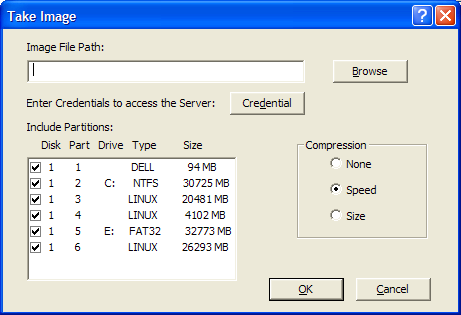
-
In the Image File Path field, specify the complete path of the shared-network location where you want to store the Windows Imaging Format (.wim) or the Ghost imaging format (.gho) files. The directory must be a Windows share or a Linux CIFS or SMB share, and you must have the Write permission to it.
NOTE:You cannot use the Browse button to select the shared-network path because it is not supported in the WinPE environment. You must specify the complete path of the network shared location.
-
In the Server Credentials field, click Credential to specify the user name and password of the remote share on the server used for storing the .wim or .gho files.
NOTE:If the remote share is a OES2 Linux CIFS share, provide the user name as domain\userid.
-
In the Include Partitions field, select the partition of the disk whose image you want to take.
By default, the Include Partitions field displays all the partitions of the device on which the Novell ZENworks Third-Party Imaging utility is launched.
NOTE:The drives displayed might not correlate with the original drives of the device. You must ensure that the correct drive is selected.
-
Select one of the following compression options:
-
None: No compression is applied.
-
Speed: Optimizes the compression to allow for the fastest imaging time. Use this option if CPU speed is an issue. By default, this option is selected.
-
Size: Optimizes the compression to minimize the image file’s size to conserve disk space. This might cause Imaging to take considerable amount of time.
-
-
Click OK.
If the images are taken in the Ghost format, ZENworks additionally creates an XML file with the filename as image_name-ghost.xml in the same location as the image file. You must not edit the xml file. If you are taking an image of a device that has multiple disks, an image file is created for each disk and only one XML file is created per image.
If you want to move a Ghost image to a different location, you must move all the image files and the XML file specific to the image.
C.5.4 Restoring a Locally Stored Image
The Novell ZENworks Third Party Imaging utility allows you to restore a locally stored image on the device.
-
(Optional) If you want to change the destination disk structure before restoring a WIM image, perform the tasks explained in Section C.7, Configuring the Destination Disk Structure Before Restoring a WIM Image.
-
Click the Imaging menu > Restore Image > Local.
The Restore Image window is displayed.
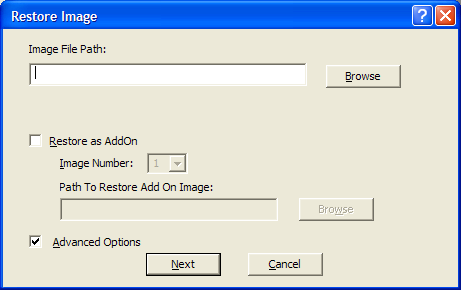
-
In the Image File Path field, specify or click Browse to browse for and select the directory containing the Windows Imaging Format (.wim) or the Ghost imaging format (.gho) file to be restored.
-
(Conditional) If you want to restore the .wim file as an add-on image:
-
Select the Restore as Add-On option.
-
Configure the following settings:
-
Image Number: Select the index number of the image to be restored.
-
Path to Restore the Add-on Image: Specify or click Browse to browse for and select the location on the device where you want to restore the add-on image.
-
-
Click OK.
-
-
(Conditional) If you want to perform any of the following operations, select Advanced Options and click Next to display the Select Partition window.
-
Restore an image that is stored on a local disk, and not on a removable or CD-ROM drive.
-
Restore a base image taken by using ImageX or Ghost.
-
Selective partition imaging.
-
View the image information and modify the disk partitions accordingly.
NOTE:The Advanced Options is available only if you are restoring a Ghost image taken by using ZENworks (through ZENworks Control Center or the Novell ZENworks Third-Party Imaging utility).
The Advanced Options is not available for the WIM Imaging format if you select the Restore as Add-On option.
-
-
(Conditional) If you select Advanced Options in Step 5, configure the Select Partition window.
The Select Partition window allows you to select the image partition to be restored and the destination drive. You can restore the image of a disk partition on any other disk partition.
If the image to be restored was taken by using ImageX, then all the images stored in the .wim file are displayed, along with their data size.If the image was taken by using ZENworks Configuration Management, then only the information for all the partitions within the .wim file is displayed.
In the Image Partitions panel, select the check box for the image partition to be restored. The image is restored on the corresponding drive in the Disk Partitions panel. If you want to restore the image of a partition to a different drive, drag and drop the desired partition in the Disk Partitions panel so that it is corresponding to the selected image partition. You can also use the Up and Down arrow keys to reorganize the partitions in the panel.
NOTE:The drives displayed in the Disk Partitions panel might not correlate with the original drives of the device. You must ensure that the correct drive is selected.
-
Click OK.
C.5.5 Restoring an Image to a Device on a Shared Network Location
The Novell ZENworks Third Party Imaging utility allows you to restore an image to the device on a shared-network path.
-
(Optional) If you want to change the destination disk structure before restoring a WIM image, perform the tasks explained in Section C.7, Configuring the Destination Disk Structure Before Restoring a WIM Image.
-
Click the Imaging menu > Restore Image > Server.
The Restore Image window is displayed.
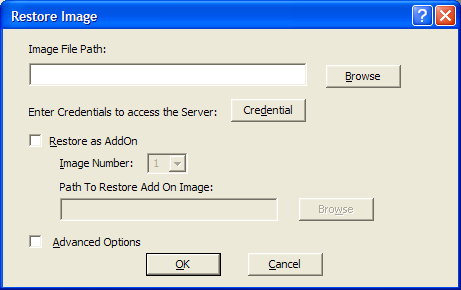
-
In the Image File Path field, specify the complete path of the shared-network location containing the Windows Imaging Format (.wim) or the Ghost imaging format (.gho) file to be restored. The directory must be a Windows share or a Linux CIFS or SMB share.
NOTE:You cannot use the Browse button to select the shared-network path because it is not supported in the WinPE environment. You must specify the complete path of the network shared location.
-
In the field, click Credential to specify the user name and password of the remote share on the server having the .wim or .gho file.
NOTE:If the remote share is a OES2 Linux CIFS share, provide the user name as domain\userid.
-
(Conditional) If you want to restore the .wim file as an add-on image:
-
Select the Restore as Add-On option.
-
Configure the following settings:
-
Image Number: Select the index number of the image to be restored.
-
Path to Restore the Add-on Image: Specify or click Browse to browse for and select the location on the device where you want to restore the add-on image.
-
-
Click OK.
-
-
(Conditional) If you want to perform any of the following operations, select Advanced Options and click Next to display the Select Partition window.
-
Restore a base image taken by using ImageX or the Ghost imaging format (.gho).
-
Selective partition imaging.
-
View the image information and modify the disk partitions accordingly.
NOTE:The Advanced Options is available only if you are restoring a Ghost image taken by using ZENworks(through ZENworks Control Center or the Novell ZENworks Third-Party Imaging utility).
The Advanced Options is not available for the WIM Imaging format if you select the Restore as Add-On option.
-
-
(Conditional) If you select Advanced Options, configure the Select Partition window.
The Select Partition window allows you to select the image partition to be restored and the destination drive. You can restore the image of a disk partition on any other disk partition.
If the image to be restored was taken by using ImageX, then all the images stored in the .wim file are displayed, along with their data size.If the image was taken by using ZENworks Configuration Management, then only the information for all the partitions within the .wim file is displayed.
In the Image Partitions panel, select the check box for the image partition to be restored. The image is restored on the corresponding drive in the Disk Partitions panel. If you want to restore the image of a partition to a different drive, drag and drop the desired partition in the Disk Partitions panel so that it is corresponding to the selected image partition. You can also use the Up and Down arrow keys to reorganize the partitions in the panel
NOTE:The drives displayed in the Disk Partitions panel might not correlate with the original drives of the device. You must ensure that the correct drive is selected
-
Click OK.
C.5.6 Adding, Deleting, or Activating Disk Partitions
The Novell ZENworks Third Party Imaging utility allows you to create, delete, and activate disk partitions.
Creating a Partition
-
Click the Partitioning menu > Modify Partition.
A list of partitions available on the device, total disk space, and the free disk space on the device is displayed. Select the disk whose partition you want to modify.
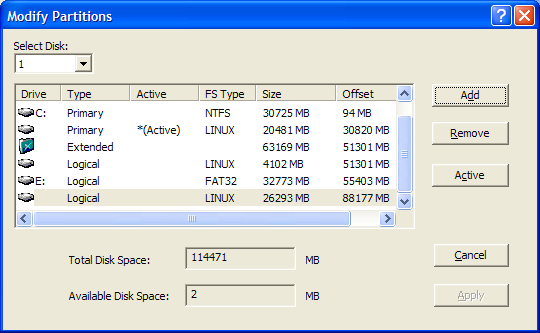
Note: The drives displayed might not correlate with the original drives of the device. You must ensure that the correct drive is selected.
-
To create a Primary or Extended partition, click Add. To create a Logical partition, select an Extended partition, then click Add.
The Add Partition window is displayed.
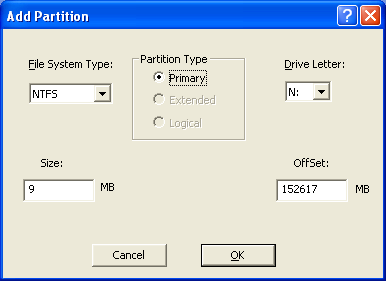
-
Configure the following settings:
-
File System Type: (Not applicable for the Extended partition) Select the file system type for the device.
-
Partition Type: Select the partition type to be created.
-
Size: Specify the size of the partition. By default, it is the free space available on the disk beyond the specified offset value for the Primary or Extended partition, and the free space available beyond the specified offset value within the Extended partition for the Logical partition.
-
Drive Letter: (Not applicable for the Extended partition) Select the letter to represent the partition.
-
OffSet: Specify the offset of the disk to determine the starting position of the partition. By default, it is the offset of the first available free space on the disk for the Primary or Extended partition, and it is the offset of the first available free space within the extended partition for the Logical partition.
-
-
Click OK.
The Modify Partitions window is displayed.
-
Click Apply.
Deleting a Partition
-
Click the Partitioning menu > Modify Partition.
A list of partitions available on the device, total disk space, and the free disk space on the device is displayed.
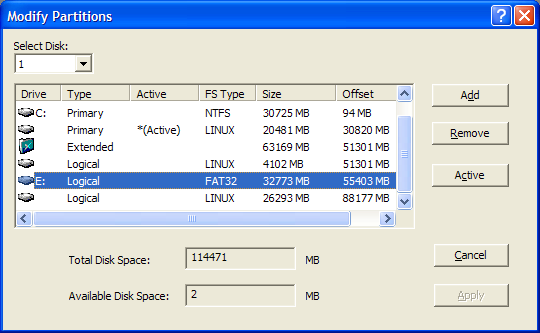
-
Select the partition to be deleted, then click Remove.
-
Click Apply.
Making a Partition Active
-
Click the Partitioning menu > Modify Partition.
A list of partitions available on the device, total disk space, and the free disk space on the device is displayed.
-
Select the primary partition to be made active, then click Active.
-
Click Apply.
C.5.7 Querying for the Third-Party Imaging Work
In the Novell ZENworks Third Party Imaging utility, click the Imaging menu > Query for Work to query for any third-party imaging task assigned to the device.
The device is not rebooted after this operation.